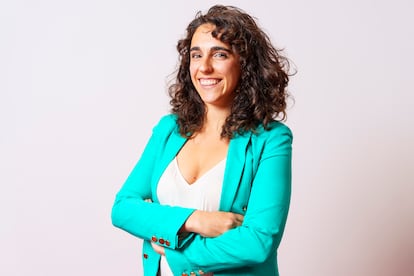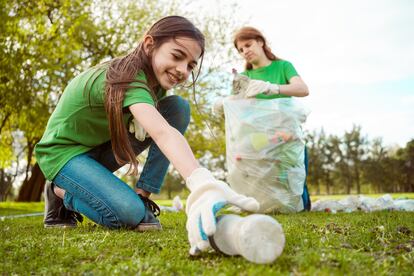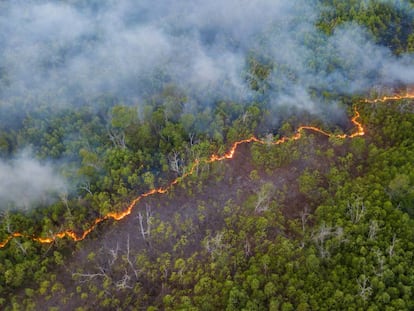Carmela del Moral, from Save the Children: ‘We must give kids a place in the decisions about climate change; they are the ones who will suffer it the most’
Minors must learn to normalize situations such as heat waves and potential future shortages, but we should never make them feel that all is lost

In 2021, Save the Children published the report Born into the Climate Crisis: Why we must act now to secure children’s rights, the result of research carried out in collaboration with an international team of climate researchers led by the Vrije Universiteit Brussel, in Brussels, which was also published in Science magazine. The document states that, with the current level of compliance with the emission reduction commitments of the Paris Agreement, children born in 2020 will face an average of seven times more scorching heat waves during their lifetime than their grandparents.
In light of these data, Carmela del Moral, head of Childhood Policies at Save the Children Spain, warns: “Without urgent action, we will be leaving our children a devastating future.” For this reason, she believes that the child population must be part of the decisions regarding climate change.
Question. What does it mean to be born into a world in climate crisis?
Answer. The U.N. — and also Save the Children — maintains that we speak of a childhood crisis, because it affects the exercise of all the rights of children and adolescents, such as the right to health, to an adequate standard of living, to be protected or to education, especially in certain parts of the world. According to the study we carried out, with the current climate forecasts, those born in 2020 will live in a world that will experience four times as many forest fires or almost four times as many droughts or floods throughout their lives. In short, we are talking about boys and girls that will inherit a world in a worse situation than that of their fathers and mothers.
Q. How does inaction against climate change impact the first years of children’s lives?
A. In different ways. There is a very clear example that has to do with body temperature. Younger children are more vulnerable during heat waves because they have a lower ability to regulate their body temperature, which makes them more prone to heat stroke or dehydration. Furthermore, climate change, especially in certain places in the world, causes significant damage to plantations and crops, resulting in problems of undernourishment and malnutrition that have a direct impact on the development of the boys and girls who go through it during their early childhood. So being exposed to these types of issues affects their future development.

Q. Will it affect boys and girls in the same way?
A. There are no studies that show a distinction in this regard, but there are, for instance, in the educational field. Along these lines, in Pakistan, after the 2010 floods, which were aggravated by climate change, 24% of sixth grade girls dropped out of school, compared to 6% of boys. Because when family income decreases, it is usually the girls who drop out of school.
Q. How should we address this issue without falling into despair?
A. It is true that we hear more and more about eco-anxiety among adolescents and children. First, we must build societies that are more resilient to the effects of climate change. Also, we must not lose hope and make them feel that all is lost. We need to prepare them to normalize the situations we are experiencing, maybe certain shortages in coming years. And, as adults, we must work so that this is not the future they will inherit.
Q. What measures must be urgently implemented to protect the children from the impact of climate change?
A. First, we must apply macromeasures that allow us to make a fair ecological transition without exceeding 1.5 degrees Celsius of global warming, something that involves eliminating our dependence on fossil fuels. Furthermore, financing for developing countries must be increased so that they can adapt their economies to climate change and promote resilient economies and societies.
For example, we must adapt the schools to prevent classrooms from reaching extreme temperatures, guaranteeing the right to education. Also, there must be social protection systems that, in the event of droughts or floods, serve as a safety net for the most vulnerable families, avoiding price increases. In addition, we must listen more to the boys and girls and give them a place in the decisions about climate change, because they are the ones who will suffer it the most.

Q. What is the role of the families when it comes to dealing with the current situation?
A. As consumers, rejecting the forms of consumption and life that promote the use of more polluting resources and practices. We must continue to educate about individual responsibility, but we have to keep demanding collective responsibilities from those who have the greatest power to do so. If the companies are not more ethical, if they don’t have a greater commitment in this sense, it is difficult for us to change things with our individual behaviors alone.
Q. What habits can parents adopt so that their children become aware of the situation we are facing?
A. They have to help them understand the world, but not in a traumatic way; they must find out what they are feeling and try to provide answers. One way to fight eco-anxiety is to involve them in municipal, neighborhood or school activities, in order for them to feel that they can change this reality.
Q. How can we help the child population to become active agents?
A. They must receive truthful information about the questions they ask. We have to guide them. See what type of neighborhood, associative and municipal initiatives there are around these issues, and accompany them. In short, we must give them the necessary tools for citizen participation, and even activism or protest. Institutions must implement accessible participation mechanisms where the voice of children and adolescents has the weight that it currently lacks.
Q. What is the role of schools in helping children embrace ways of life that favor coexistence in a more sustainable environment?
A. In addition to teaching responsible consumption habits, schools must provide scientific and truthful information that counteracts the denialist discourse about the climate crisis that is spread through social media and which can be a source of misinformation. They also have the task of explaining what climate change means, in addition to supporting the processes of change in consumption, perception and individuality. And of course, they must aspire, as schools, to be increasingly sustainable and to become spaces that are resilient to the consequences of climate change.
Sign up for our weekly newsletter to get more English-language news coverage from EL PAÍS USA Edition
Tu suscripción se está usando en otro dispositivo
¿Quieres añadir otro usuario a tu suscripción?
Si continúas leyendo en este dispositivo, no se podrá leer en el otro.
FlechaTu suscripción se está usando en otro dispositivo y solo puedes acceder a EL PAÍS desde un dispositivo a la vez.
Si quieres compartir tu cuenta, cambia tu suscripción a la modalidad Premium, así podrás añadir otro usuario. Cada uno accederá con su propia cuenta de email, lo que os permitirá personalizar vuestra experiencia en EL PAÍS.
¿Tienes una suscripción de empresa? Accede aquí para contratar más cuentas.
En el caso de no saber quién está usando tu cuenta, te recomendamos cambiar tu contraseña aquí.
Si decides continuar compartiendo tu cuenta, este mensaje se mostrará en tu dispositivo y en el de la otra persona que está usando tu cuenta de forma indefinida, afectando a tu experiencia de lectura. Puedes consultar aquí los términos y condiciones de la suscripción digital.
More information
Últimas noticias
‘I thought you would like it’: The risky sexual practice popularized by TV shows and TikTok
The digitalization of tourism: ‘They promise experiences and gave us the worst possible one’
Mexican peso defies uncertainty with forecasts of a new period of stability in 2026
Meghan Markle’s year of redemption: Numerous projects, some setbacks and a brand that is finally taking off
Most viewed
- Sinaloa Cartel war is taking its toll on Los Chapitos
- Oona Chaplin: ‘I told James Cameron that I was living in a treehouse and starting a permaculture project with a friend’
- Reinhard Genzel, Nobel laureate in physics: ‘One-minute videos will never give you the truth’
- Why the price of coffee has skyrocketed: from Brazilian plantations to specialty coffee houses
- Silver prices are going crazy: This is what’s fueling the rally










































